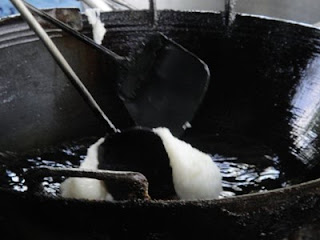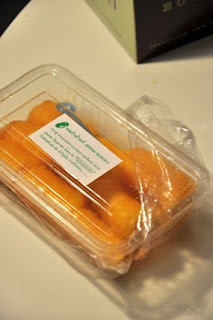
Speaking of indulgence during Thanksgiving, the fried sesame balls are the Asian version with a festive origin, though similar to the perfectly roasted turkey, these fried treats have also managed to trickled into the repertoire of the daily menu. From the corner congee shop to an extravagance dim sum parlour, these fragrant jewels with a unique mochi-chewy texture are here to stay, and sometimes with a hidden luscious molten surprise.
As simple and innocent as this golden gem appears, the making itself is a perfect marriage of science and art. The gleaming hot oil transfer the kinetic energy into the pocketed air within a dense glutinous dough. As the air expands in a discordance manner, this is where the artist comes in. Exercising his/her craftsmanship, the chef is able to engineer a uniform sphere with the precise thickness that brings forth the perfect union of texture, flavour, and scent. The delicate architecture of the crust comprised of a thin crispy armor, layered with a chewy comforting interior to showcased the aroma of sweet rice, without carrying the heaviness from the fried nature.

The Vietnamese version, Xoi chien phong just bring this art to a whole new horizon. It was hard to imagine with a wok filled with fragrant oil and two long utensils, the magician has managed to transform a dough of less than 5 ingredients, into a steaming alluring sculpture that is the size of a watermelon. I hope that this art will not be lost in translation, but growing enthusiastic crowd of unique dines, my fears should be nothing but a misty veil..





~ Traditional Chinese Sesame Balls ~
500g Glutinous flour
100g Water
100g Sugar
~2L Vegetable Oil
Filling is optional, but can use Adzuki paste, Black Sesame paste, Mung Bean paste, or to be more adventurous, you can try to incorporate Western ingredients like pumpkin or sweet potato puree!
1) Mix 100g of glutinous flour with 100g of water, and knead it to form a dough.
2) Cook the dough in boiling water until it floats and cooked through. It will turn slightly transparent.
3) Place the cooked dough in a mixing bowl and knead in the remaining flour and sugar, until it comes to a doughy consistancy.
4) Form dough balls with 1.5 inches in diameter. Flatten the dough and use it to encase the filling.
5) Heat the oil in a deep pot to 325oF, and using the double fried method, fry the dough balls to till it is light golden in colour. The balls should double in size. Remove them from the pot and increase the temperature of the oil to 375oF. Fry the partially cooked balls till it is golden amber.
Bon Appetit~!





